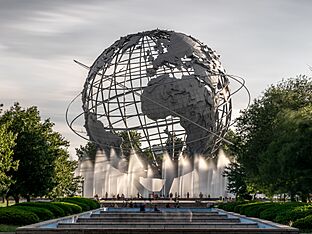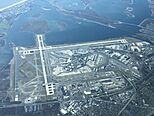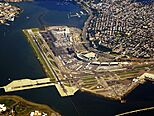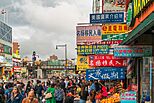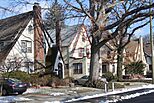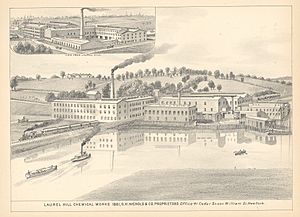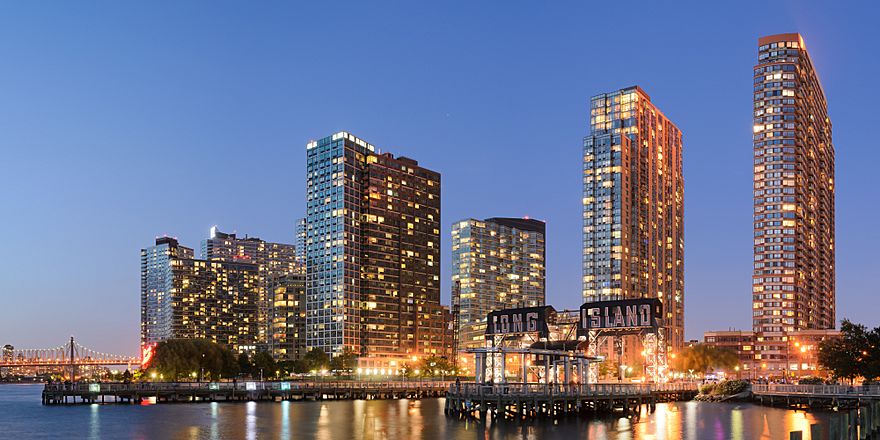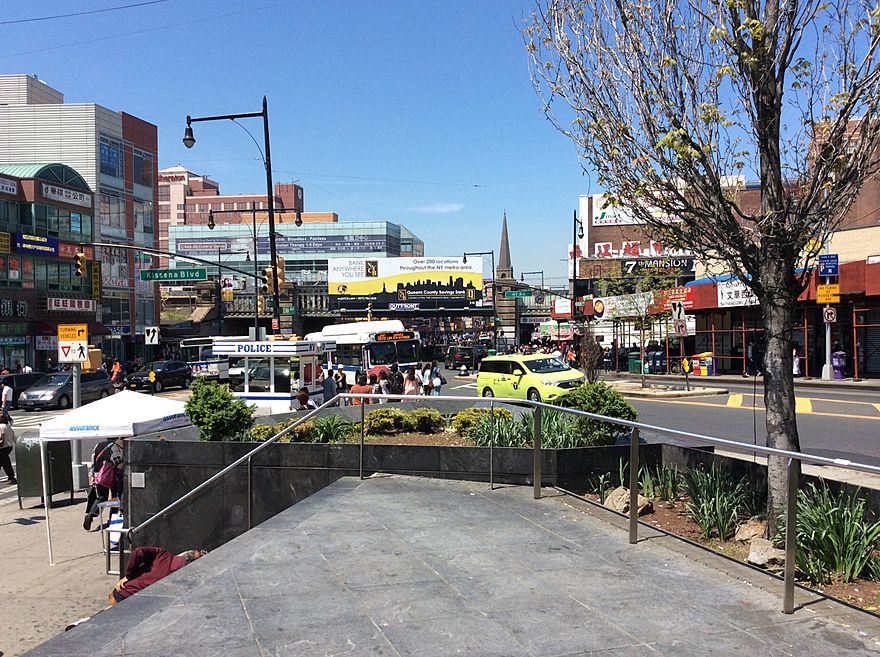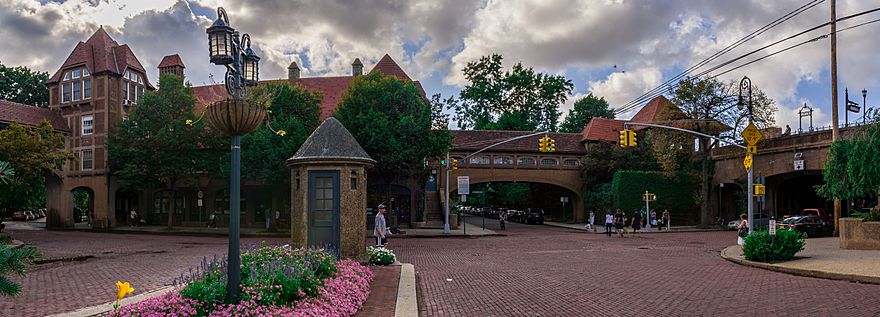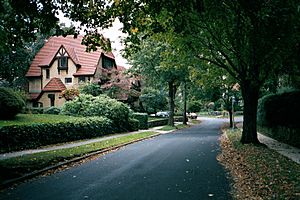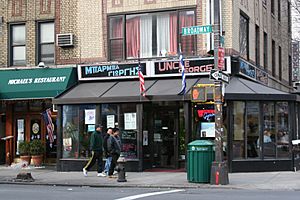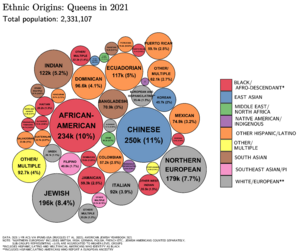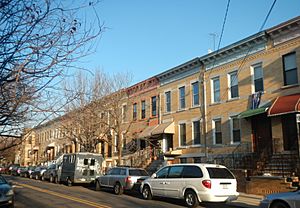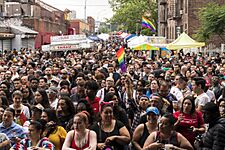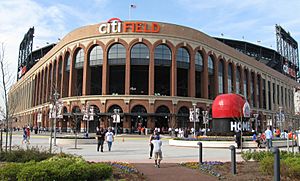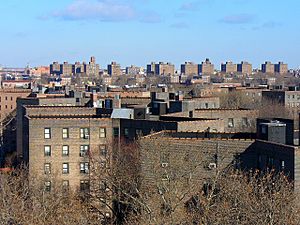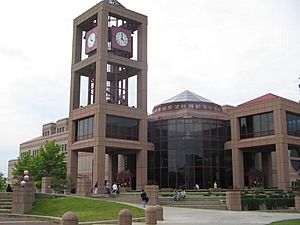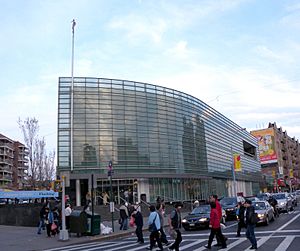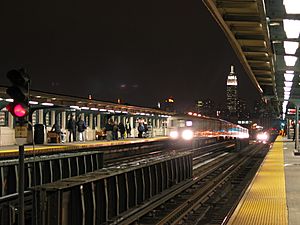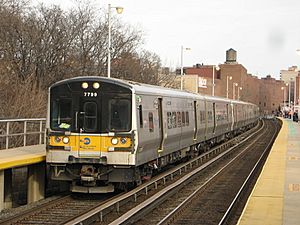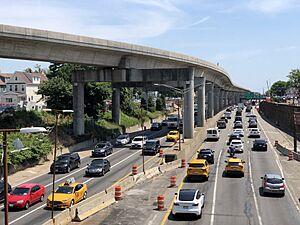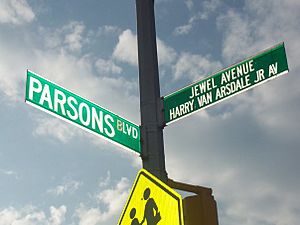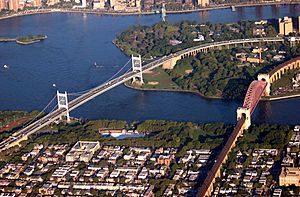Queens facts for kids
Quick facts for kids
Queens
Queens County, New York
|
|||
|---|---|---|---|
|
Downtown Flushing
Arthur Ashe Stadium
|
|||
|
|||
| Country | |||
| State | |||
| County | Queens (coterminous) | ||
| City | New York City | ||
| Settled | 1683 | ||
| Named for | Catherine of Braganza | ||
| Government | |||
| • Type | Borough (New York City) | ||
| Area | |||
| • Total | 178 sq mi (460 km2) | ||
| • Land | 109 sq mi (280 km2) | ||
| • Water | 70 sq mi (200 km2) 39% | ||
| Highest elevation | 258.2 ft (78.7 m) | ||
| Population
(2020)
|
|||
| • Total | 2,405,464 |
||
| • Density | 22,068/sq mi (8,521/km2) | ||
| Demonym(s) | Queensite | ||
| GDP | |||
| • Total | US3.325 billion (2022) | ||
| ZIP Code prefixes |
111--, 113--, 114--, 116--, 11004-5
|
||
| Area codes | 718/347/929 and 917 | ||
| Congressional districts | 3rd, 5th, 6th, 7th, 14th | ||
Queens is the biggest borough in New York City by land area. It is also known as Queens County and is located in the state of New York. Queens is on the western part of Long Island. It shares borders with Brooklyn and Nassau County. It also has water borders with Manhattan, the Bronx, and Staten Island, as well as with New Jersey. Queens is known for being the most diverse place in the world, with many different languages and cultures.
In 2020, Queens had a population of over 2.4 million people. This makes it the second most populated county in New York state, right after Brooklyn. If Queens were its own city, it would be the fourth largest in the United States. About 47% of the people living in Queens were born in other countries, making it a very diverse place.
Queens was created in 1683. It was one of the first 12 counties in the Province of New York. The area was named after Catherine of Braganza, who was the Queen of England at that time. From 1683 to 1899, Queens County also included what is now Nassau County. In 1898, Queens became a borough of New York City. This happened when several towns like Long Island City, Newtown, Flushing, Jamaica, and parts of Hempstead joined together. Today, all of these, except Hempstead, are neighborhoods within Queens.
Queens has a very strong and varied economy. It is home to two of New York City's major airports: John F. Kennedy (JFK) and LaGuardia Airport. Famous places in Queens include Flushing Meadows–Corona Park, Citi Field (where the New York Mets baseball team plays), and the USTA Billie Jean King National Tennis Center, which hosts the U.S. Open tennis tournament. Other important sites are Kaufman Astoria Studios, Silvercup Studios, and the Aqueduct Racetrack. Areas like Flushing and Long Island City are growing quickly with new buildings and businesses.
History of Queens
Early Settlements and Colonial Times
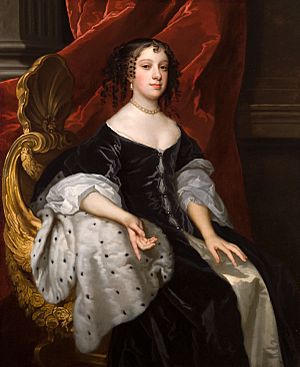
European settlers from the Dutch and English arrived in Queens as part of the New Netherland colony. The first settlements began in 1635. Early towns included Maspeth (1642) and Vlissingen (now Flushing) in 1643. Other early settlements were Newtown (now Elmhurst) and Jamaica. Most of these towns were settled by English people from New England. They lived under Dutch laws. In 1664, the English took over the colony and renamed it New York. The area, including all of Long Island, became known as Yorkshire.
In 1657, colonists signed the Flushing Remonstrance. This document protested the Dutch rulers treating Quakers unfairly. It is seen as an early step towards the idea of freedom of religion in the U.S. Constitution.
Queens County was one of the first twelve counties created in New York State on November 1, 1683. It was named after Catherine of Braganza, who was the Queen of England at the time. The county was created along with Kings County (named after her husband, King Charles II) and Richmond County. Over time, Queens gained some islands in the East River and Long Island Sound.
Queens During the American Revolution
Queens played a smaller role in the American Revolution compared to Brooklyn. After the Battle of Long Island in 1776, the British occupied Queens. They stayed there for most of the war. British soldiers used public inns and empty buildings in Queens as their living quarters. This was allowed by the Quartering Acts. Even though many locals did not like this, many people in Queens supported the British. The Third Amendment to the United States Constitution later made it illegal to house soldiers in private homes during peacetime. Nathan Hale, an American spy, was captured by the British in Flushing Bay in Queens. He was later executed in Manhattan.
From 1683 to 1784, Queens County had five towns: Flushing, Hempstead, Jamaica, Newtown, and Oyster Bay. In 1784, the Town of North Hempstead was formed from the northern part of Hempstead. Jamaica was the first county seat. After the war, a new courthouse was built near Mineola.
In 1870, Long Island City became its own city, separating from Newtown. Around 1874, the county government moved to Long Island City from Mineola. Some islands that were part of Queens were later transferred to other counties. For example, Rikers Island moved to New York County (Manhattan) in 1884.
Becoming a Borough of New York City
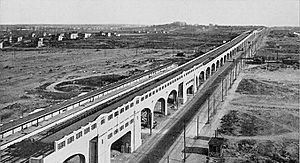
On May 4, 1897, the New York State Legislature approved Queens becoming a borough of New York City. This happened after people voted for it in 1894. On January 1, 1898, Queens Borough was officially created. Long Island City, Newtown, Flushing, Jamaica, and the Rockaway Peninsula (from Hempstead) all joined to form the new borough. All their old local governments were dissolved. The parts of Queens County that did not join New York City, like North Hempstead and Oyster Bay, formed Nassau County in 1899. After this, the borders of Queens County and the Borough of Queens became the same. Jamaica became the county seat again. Today, county offices are also in Kew Gardens.
From 1905 to 1908, the Long Island Rail Road in Queens became electric. New ways to travel to Manhattan opened up. The Queensboro Bridge was finished in 1909. Railway tunnels under the East River opened in 1910. Starting in 1915, much of Queens was connected to the New York City Subway system. With these new connections and more people using cars, Queens' population more than doubled between 1920 and 1930.
Queens hosted the 1939 New York World's Fair and the 1964 New York World's Fair. LaGuardia Airport opened in 1939. JFK Airport (originally Idlewild Airport) opened in 1948. In 2001, American Airlines Flight 587 crashed in Queens' Belle Harbor area, sadly killing 265 people. In 2012, Hurricane Sandy caused a large fire that destroyed much of the Breezy Point area in Queens.
Geography of Queens
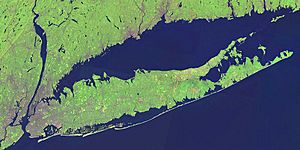
Queens is on the far western part of Long Island. It also includes some smaller islands, mostly in Jamaica Bay. These islands are part of the Gateway National Recreation Area. This area is one of the National Parks of New York Harbor. Queens County covers about 178 square miles. About 109 square miles are land, and 70 square miles (39%) are water.
Brooklyn is the only other New York City borough on Long Island. It is just south and west of Queens. Newtown Creek, a waterway that flows into the East River, forms part of the border. To the west and north of Queens is the East River. Across the river is Manhattan to the west and The Bronx to the north. Nassau County is to the east of Queens on Long Island. Staten Island is southwest of Brooklyn and has a small water border with Queens.
The Rockaway Peninsula is the southernmost part of Long Island. It is located between Jamaica Bay and the Atlantic Ocean. This area has the most popular public beaches in Queens. Flushing Bay and the Flushing River are in the north, connecting to the East River. The East River then flows into Long Island Sound. The middle part of Queens has hills formed by the Wisconsin Glacier.
Queens' Landscapes
Climate in Queens
Queens has a humid subtropical climate. This means it has hot, humid, and wet summers. Winters are relatively mild compared to other parts of New York State, but snow is common. Blizzards happen about every 4–6 years. Spring weather can change a lot, from chilly to very warm. Autumn is similar to spring. Snowfall usually starts in December.
| Monthly and annual statistics for the three main climatology stations in New York City | ||||||||||||||||||||||||||||||||||||||||||||||||||||||||||||||||||||||||||||||||||||||||||||||||||||||||||||||||||||||||||||||||||||||||||||||||||||||||||||||||||||||||||||||||||||||||||||||||||||||||||||||||||||||||||||||||||||||||||||||||||||||||||||||||||||||||||||||||||||||||||||||||||||||||||||||||||||||||||||||||||||||||||||||||||||||||||||||||||||||||||||||||||||||||||||||||||||||||
|---|---|---|---|---|---|---|---|---|---|---|---|---|---|---|---|---|---|---|---|---|---|---|---|---|---|---|---|---|---|---|---|---|---|---|---|---|---|---|---|---|---|---|---|---|---|---|---|---|---|---|---|---|---|---|---|---|---|---|---|---|---|---|---|---|---|---|---|---|---|---|---|---|---|---|---|---|---|---|---|---|---|---|---|---|---|---|---|---|---|---|---|---|---|---|---|---|---|---|---|---|---|---|---|---|---|---|---|---|---|---|---|---|---|---|---|---|---|---|---|---|---|---|---|---|---|---|---|---|---|---|---|---|---|---|---|---|---|---|---|---|---|---|---|---|---|---|---|---|---|---|---|---|---|---|---|---|---|---|---|---|---|---|---|---|---|---|---|---|---|---|---|---|---|---|---|---|---|---|---|---|---|---|---|---|---|---|---|---|---|---|---|---|---|---|---|---|---|---|---|---|---|---|---|---|---|---|---|---|---|---|---|---|---|---|---|---|---|---|---|---|---|---|---|---|---|---|---|---|---|---|---|---|---|---|---|---|---|---|---|---|---|---|---|---|---|---|---|---|---|---|---|---|---|---|---|---|---|---|---|---|---|---|---|---|---|---|---|---|---|---|---|---|---|---|---|---|---|---|---|---|---|---|---|---|---|---|---|---|---|---|---|---|---|---|---|---|---|---|---|---|---|---|---|---|---|---|---|---|---|---|---|---|---|---|---|---|---|---|---|---|---|---|---|---|---|---|---|---|---|---|---|---|---|---|---|---|---|---|---|---|---|---|---|---|---|---|---|---|---|---|---|---|---|---|---|---|---|---|---|---|---|---|---|---|---|---|---|---|---|---|---|---|---|---|---|---|---|---|---|---|---|---|---|---|---|---|---|---|---|---|---|---|
|
||||||||||||||||||||||||||||||||||||||||||||||||||||||||||||||||||||||||||||||||||||||||||||||||||||||||||||||||||||||||||||||||||||||||||||||||||||||||||||||||||||||||||||||||||||||||||||||||||||||||||||||||||||||||||||||||||||||||||||||||||||||||||||||||||||||||||||||||||||||||||||||||||||||||||||||||||||||||||||||||||||||||||||||||||||||||||||||||||||||||||||||||||||||||||||||||||||||||
|
||||||||||||||||||||||||||||||||||||||||||||||||||||||||||||||||||||||||||||||||||||||||||||||||||||||||||||||||||||||||||||||||||||||||||||||||||||||||||||||||||||||||||||||||||||||||||||||||||||||||||||||||||||||||||||||||||||||||||||||||||||||||||||||||||||||||||||||||||||||||||||||||||||||||||||||||||||||||||||||||||||||||||||||||||||||||||||||||||||||||||||||||||||||||||||||||||||||||
Neighboring Counties
- Bronx County (north)
- Nassau County (east)
- Kings County (west)
- New York County (northwest)
Queens Neighborhoods

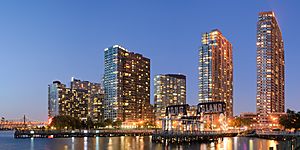
Queens has many unique neighborhoods. Each one has its own special feel. The postal service uses four main zones in Queens. These are based on the old towns that existed before Queens became a borough. These zones are Long Island City (ZIP codes starting with 111), Jamaica (114), Flushing (113), and Far Rockaway (116). Sometimes, the names of post office stations are used in addresses, which can be different from the traditional neighborhood names. Neighborhood boundaries are often not very clear. For example, Forest Hills and Rego Park overlap.
People in Queens often feel a strong connection to their specific neighborhood. Here are some of the diverse neighborhoods:
- Flushing is one of the largest neighborhoods. It has a big and growing Asian community. This includes people from China, Korea, and South Asia. This community has spread eastward into areas like Murray Hill, Whitestone, Bayside, and Douglaston–Little Neck. These areas used to have many Italian and Greek residents, as well as Latino people. The center of Downtown Flushing and the Flushing Chinatown is a busy intersection of Main Street, Kissena Boulevard, and 41st Avenue. This area is sometimes called the "Chinese Times Square". Flushing is home to one of the largest Chinese populations outside of China.
- Howard Beach, Whitestone, and Middle Village have many Italian American residents.
- Ozone Park and South Ozone Park have large Italian, Hispanic, and Guyanese populations.
- Rockaway Beach has a large Irish American population.
- Astoria, in the northwest, has traditionally been home to one of the largest Greek populations outside of Greece. It also has many Spanish and Italian communities. More recently, people from the Middle East, South Asia, and the Balkans have moved there. Young professionals from Manhattan are also moving to Astoria. Nearby Long Island City is a big business area and home to Queensbridge, the largest public housing project in North America.
- Maspeth and Ridgewood have many Eastern European immigrants. These include people from Romania, Poland, Serbia, Albania, and other Slavic countries. Ridgewood also has a large Hispanic population.
- Jackson Heights and Elmhurst are home to many Hispanic, Asian, Tibetan, and South Asian communities. Jackson Heights is sometimes called "Little Colombia" because of its many Colombian residents and restaurants.
- Woodside has a large Filipino American community, known as "Little Manila". It also has a large Irish American population. Many Filipino Americans also live in Hollis and Queens Village.
- Richmond Hill, in the south, is often called "Little Guyana" due to its large Guyanese community. It also has "Punjab Avenue" for its many Punjabi residents.
- Rego Park, Forest Hills, Kew Gardens, and Kew Gardens Hills have traditionally large Jewish populations. These include people from Germany, Eastern Europe, Israel, Iran, and the former Soviet Union. These neighborhoods are also seeing more Asian residents, mainly from China.
- Jamaica Estates, Jamaica Hills, Hillcrest, Fresh Meadows, and Hollis Hills also have many Jewish residents. Many Asian families live in parts of Fresh Meadows too.
- Jamaica is home to many African American, Caribbean, and Central American people. There are also middle-class African American and Caribbean neighborhoods like Saint Albans, Queens Village, Cambria Heights, Springfield Gardens, Rosedale, Laurelton, and Briarwood in eastern and southeastern Queens.
- Bellerose and Floral Park used to have many Irish Americans. Now, they have a growing South Asian population, mostly Indian Americans.
- Corona and Corona Heights were once known as the "Little Italy" of Queens. They were mostly Italian with a strong African American community in the northern part of Corona and East Elmhurst. Today, Corona has the highest number of Latino residents in Queens. It also has a growing Chinese American population, located between Elmhurst and Flushing.
Queens Demographics
|
New York City's five boroughs
|
||||||
|---|---|---|---|---|---|---|
| Jurisdiction | Population | Land area | Density | |||
| Borough | County | Estimate (2015) |
square miles |
square km |
persons / sq. mi |
persons / sq. km |
|
|
|
1,644,518 | 22.83 | 59.1 | 72,033 | 27,826 |
|
|
|
1,455,444 | 42 | 110 | 34,653 | 13,231 |
|
|
|
2,636,735 | 71 | 180 | 37,137 | 14,649 |
|
|
|
2,339,150 | 109 | 280 | 21,460 | 8,354 |
|
|
|
474,558 | 58.5 | 152 | 8,112 | 3,132 |
|
|
8,550,405 | 303.33 | 781.1 | 28,188 | 10,947 | |
|
|
19,795,791 | 47,214 | 122,284 | 416.4 | 159 | |
|
|
||||||
| Racial composition | 2020 | 2010 | 1990 | 1970 | 1950 |
|---|---|---|---|---|---|
| White | 25.8% | 39.7% | 57.9% | 85.3% | 96.5% |
| —Non-Hispanic | 22.8% | 27.6% | 48.0% | n/a | n/a |
| Black or African American | 16.8% | 19.1% | 21.7% | 13.0% | 3.3% |
| Hispanic or Latino (of any race) | 27.8% | 27.5% | 19.5% | 7.7% | n/a |
| Asian | 27.5% | 22.9% | 12.2% | 1.1% | 0.1% |
|
||||||||||||||||||||||||||||||||||||||||||||||||||||||||||||||||||||||||||||||||||||||||||||||||||||||||||||
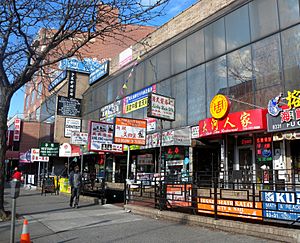
In 2020, 2,405,464 people lived in Queens. The population of Queens has grown over the years. In 2018, about 2.2 million people lived there. Queens makes up about 27% of New York City's total population. In 2018, there were about 865,878 homes in Queens. The average household had almost 3 people. About 44.5% of homes were owned by the people living in them.
In 2010, the racial makeup of Queens was 39.7% White, 19.1% Black or African American, and 22.9% Asian. About 27.5% of the population was Hispanic or Latin American. By 2019, non-Hispanic whites made up about 24.4% of the population. Black or African Americans were 17.3%. The largest minority groups were Hispanic and Latin Americans (28.2%) and Asians (26.0%).
In Queens, about 47.5% of residents were born in other countries in 2018. Of these, almost half were born in Latin America. About a third were born in Asia. Most of the rest were from Europe. About 44.2% of people over 5 years old speak English at home. About 23.8% speak Spanish. Many other languages are also spoken.
Queens is known for its incredible diversity. A study in 2001 found it was the most diverse county in the U.S. among counties with over 100,000 people. In 2017, another study confirmed Queens was the most diverse large county in the United States.
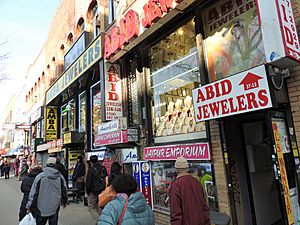
Among Asian groups in 2010, Chinese people were the largest group. They made up 10.2% of Queens' population. Other large Asian groups include Koreans, Filipinos, and various South Asian groups like Indians, Bangladeshis, and Pakistanis. Queens has the second largest Sikh population in the country.
Among Hispanic or Latin American groups, Puerto Ricans were the largest in 2010. Mexicans and Dominicans were also large groups. Queens has the largest Colombian, Ecuadorian, and Peruvian populations in New York City. The Mexican population in Queens has grown a lot.
Queens is home to almost half of New York City's Asian population. It has the largest number of Chinese, Indian, Korean, Filipino, Bangladeshi, and Pakistani residents among the five boroughs.
Some main European backgrounds in Queens include Italian, Irish, German, Polish, Russian, and Greek. Queens has the third largest Bosnian population in the United States.
About 9% of Queens residents were Jewish in 2011. Many Russian-speaking Jewish people live in Queens.
Interestingly, Black and African American residents in Queens earn more than non-Hispanic whites on average. Many of these Black families live in middle-class neighborhoods like Laurelton and Cambria Heights. These areas have higher than average family incomes. Many European Americans have moved out of some parts of Queens, like Ozone Park and Flushing. Asian Americans have often replaced them. Queens has become a very popular place to live. Many people want to live there because it's close to Manhattan but feels less like a big city.
Languages Spoken in Queens
In 2000, it was reported that 138 languages are spoken in Queens. A 2010 study found that over half of the people in Queens (ages 5 and up) speak a language other than English at home.
Language |
|---|
| Ages 5+ |
| % |
| Source → |
| 1 | 2 | 3 | 4 | 5 | 6 | 7 | 8 | 9 | 10 | 11 | 12 | 13 | 14 | 15 | 16 | 17 | 18 | 19 | 20 | 21 | 22 | 23 | 24 | 25 | 26 | 27 | 28 | 29 | 30 | |
|---|---|---|---|---|---|---|---|---|---|---|---|---|---|---|---|---|---|---|---|---|---|---|---|---|---|---|---|---|---|---|
| English | Spanish | Chinese | Various Indic |
Korean | Russian | Italian | Tagalog | Greek | French Creole |
Polish | Hindi | Urdu | Other Asian |
Other Indo- Euro pean |
French | Arabic | Serbo- Croatian |
Hebrew | Various African |
Portu- guese |
Persian | Gujarati | German | Japa nese |
Other Slavic |
Other Pacific Island |
Hungar- ian |
Thai | Viet- namese |
All non- English |
| 905,890 | 493,462 | 166,570 | 71,054 | 56,701 | 34,596 | 32,268 | 31,922 | 31,651 | 27,345 | 24,118 | 19,868 | 19,262 | 18,931 | 16,435 | 14,685 | 12,505 | 10,008 | 9,410 | 8,787 | 7,364 | 7,308 | 6,942 | 6,927 | 6,723 | 4,884 | 4,667 | 3,053 | 2,830 | 2,636 | 1,160,483 |
| 43.84 | 23.88 | 8.06 | 3.44 | 2.74 | 1.67 | 1.56 | 1.54 | 1.53 | 1.32 | 1.17 | 0.96 | 0.93 | 0.92 | 0.80 | 0.71 | 0.61 | 0.48 | 0.46 | 0.43 | 0.36 | 0.35 | 0.34 | 0.34 | 0.33 | 0.24 | 0.23 | 0.15 | 0.14 | 0.13 | 56.16 |
Religion in Queens
In 2010, the largest religious group in Queens was Roman Catholics. They had over 677,000 members in 100 churches. Other large groups included Muslims, Orthodox Jews, and various Christian groups. There were also many Hindus and Buddhists. In 2014, Queens had 738 religious organizations, showing its diverse faith communities.
Culture in Queens
Queens has been a key place for music, especially punk rock. The famous band Ramones started in Forest Hills. Many other well-known artists have lived in Queens, like Tony Bennett, Francis Ford Coppola, Paul Simon, and Robert Mapplethorpe.
Queens also has its own Poet Laureates, who are poets chosen to represent the borough.
Queens has a rich African American culture. Places like The Afrikan Poetry Theatre and the Black Spectrum Theater Company support this. In the 1940s, Queens was a big center for jazz music. Jazz legends like Louis Armstrong, Charlie Parker, and Ella Fitzgerald lived there. They found a welcoming community away from segregation. Many famous hip-hop artists also come from Queens. These include Nas, Run-D.M.C., LL Cool J, A Tribe Called Quest, 50 Cent, and Nicki Minaj.
Queens has many museums and cultural places for its diverse communities. These range from historical sites like the John Bowne House to science museums like the New York Hall of Science. There are also art galleries like the Noguchi Museum and unique graffiti exhibits like 5 Pointz.
Some of Queens' cultural institutions include:
- 5 Pointz
- Afrikan Poetry Theatre
- Bowne House
- Flushing Town Hall
- King Manor
- MoMA PS1
- Museum of the Moving Image
- Noguchi Museum
- New York Hall of Science
- Queens Botanical Garden
- Queens Museum of Art
- SculptureCenter
- Hindu Temple Society of North America
- Jamaica Center for Arts and Learning
The travel magazine Lonely Planet named Queens the top U.S. destination in 2015. They praised its cultural and food diversity. They said Queens is "quickly becoming its hippest" and a true "global melting pot."
Food in Queens
The food in Queens shows its huge cultural diversity. The food in a neighborhood often matches the people who live there. For example, Astoria has many Greek restaurants because of its large Greek population. Jackson Heights is known for its amazing Indian cuisine and many Latin American restaurants.
The Queens Night Market is a popular event in Flushing Meadows–Corona Park. It runs on Saturdays from April to October. It offers food from dozens of countries, with prices capped at $6. Up to 20,000 people attend each night.
Queens Economy
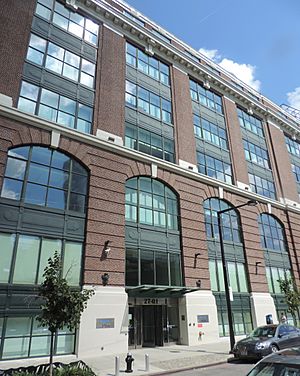
Queens has the second largest economy among New York City's five boroughs, after Manhattan. In 2004, Queens had about 440,000 private-sector jobs. By 2012, this number grew to over 486,000 jobs. Queens has the most varied economy of all the boroughs. Jobs are spread out across health care, retail, manufacturing, construction, transportation, and film and TV production. No single industry is too dominant.
Queens' diverse economy means many jobs serve customers outside the region. These include transportation, manufacturing, and business services. This makes up over 27% of all jobs in Queens. These jobs offer a higher average salary than local jobs.
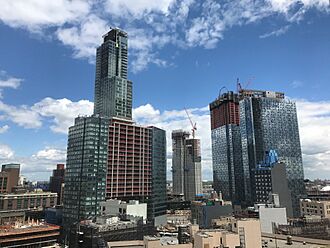
The largest job sector in Queens used to be trade, transportation, and utilities. In 2012, health care and social services became the biggest sector. Queens is home to JFK International Airport and LaGuardia Airport. These airports are among the busiest in the world. The airline industry is very important to Queens' economy. It provides a lot of jobs and wages in the transportation sector.
Education and health services were also a large sector. Manufacturing and construction are big industries in Queens. They made up almost 17% of private sector jobs in 2004. Information, finance, and business services also make up a significant part of the jobs.
As of 2003, Queens had almost 40,000 businesses. Small businesses are very important to the economy. Two-thirds of all businesses employ only one to four people.
Several large companies have their main offices in Queens. These include watchmaker Bulova in East Elmhurst. The famous piano maker Steinway & Sons is in Astoria. Glacéau, which makes Vitamin Water, is headquartered in Whitestone. JetBlue Airways has its main office in Long Island City.
Long Island City is a major center for manufacturing and office work. Flushing is a big business hub for Chinese American and Korean American companies. Jamaica is the main civic and transportation center for the borough.
Sports in Queens
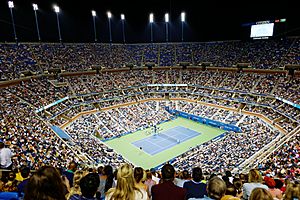
Queens is home to the New York Mets baseball team. They are part of Major League Baseball. The Mets started in 1962. They have won two World Series championships and five National League pennants. Citi Field is a stadium with 41,922 seats. It opened in April 2009 in Flushing Meadows–Corona Park. It is the Mets' home field. Shea Stadium, the Mets' old home, used to be where Citi Field's parking lot is now. It was used from 1964 to 2008. Queens will also be the future home of the Etihad Park for New York City FC, a soccer team. This stadium is expected to be ready in 2027.
The U.S. Open tennis tournament has been held in Queens since 1978. It takes place at the USTA Billie Jean King National Tennis Center, which is near Citi Field. Arthur Ashe Stadium is part of this center. With 23,771 seats, it is the biggest tennis stadium in the world. The U.S. Open used to be played at the West Side Tennis Club in Forest Hills.
South Ozone Park is home to Aqueduct Racetrack. This track hosts Thoroughbred horse racing from late October through April.
Housing in Queens
Housing in Queens is very varied. You can find tall apartment buildings in western and central Queens. Examples include Forest Hills, Jackson Heights, Flushing, Astoria, and Long Island City. In the eastern part of the borough, there are more lower-rise homes. In 2022, there were over 911,000 housing units.
Many affordable rental and co-operative housing units were built under the Mitchell–Lama Housing Program. Public housing is managed by the New York City Housing Authority. This agency provides homes for over 30,000 residents in more than 15,300 units.
Education in Queens
Schools for Kids and Teens
Queens has many public and private schools for elementary and secondary education. Public schools are run by the New York City Department of Education. This is the largest public school system in the United States. Most private schools are connected to Catholic or Jewish religious groups.
Townsend Harris High School in Queens is a special public high school for humanities. It is often ranked among the top 100 high schools in the U.S. Another top school is the Queens High School for the Sciences at York College. This school focuses on science and math. It is one of the best high schools in the state and country. It is one of the smaller specialized high schools that requires an entrance exam.
Colleges and Universities
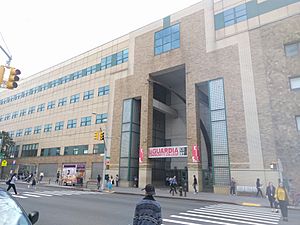
- LaGuardia Community College is part of the City University of New York (CUNY). It is called "The World's Community College" because its students come from over 150 countries. The college is known for its diverse international student body.
- Queens College is one of the best colleges in the CUNY system. It was started in 1937 to offer a strong education in liberal arts. It has over 16,000 students from 120 countries. Queens College is also home to CUNY's law school.
- Queensborough Community College is in Bayside and is also part of CUNY. It helps students prepare to attend other CUNY colleges.
- St. John's University is a private Catholic university. It was founded in 1870. It has over 19,000 students. St. John's is known for its pharmacy, business, and law programs.
- Vaughn College of Aeronautics and Technology is a private college near LaGuardia Airport. It focuses on aviation and technology.
- York College is another leading CUNY college. It offers bachelor's degrees in many subjects. It is known for its Health Sciences Programs.
Queens Public Library
The Queens Public Library is the public library system for the borough. It is one of the largest public library systems in the United States. The first Queens library opened in Flushing in 1858. The Queens Public Library has 63 branches across the borough. In 2001, people borrowed 16.8 million items from the library. It has had the highest number of borrowed items of any city library since 1985. The library has collections in many languages, including Spanish, Chinese, Korean, Russian, and more.
Transportation in Queens
In 2011–2015, about 38% of homes in Queens did not own a car. This is lower than the citywide rate of 55%.
Ride Services
As of 2019, New York City had about 80,000 for-hire cars. Two-thirds of these were ride-hail services like Uber and Lyft. There are also about 13,500 traditional yellow taxis.
Car Sharing
Companies like Zipcar offer car sharing in New York City. In 2018, the city started a program for on-street car sharing. This program was very popular in Queens, especially in Jackson Heights, Jamaica, and Far Rockaway.
Bikes and Scooters
Citi Bike is a bike-sharing company. In 2019, it had 169,000 yearly members. In 2021, the city announced it would double Citi Bike's service area. This expansion includes new stations in Astoria, Sunnyside, and Woodside. E-moped and e-scooter sharing services also started in the city in 2019 and 2021.
Airports in Queens
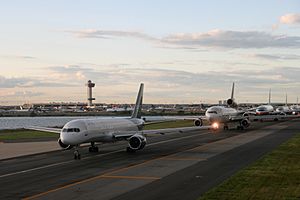
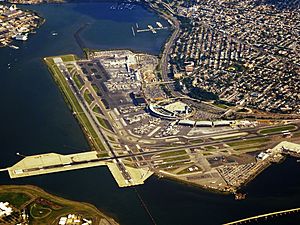
| Airline Revenue Passengers at Queens Airports 2019 → pre-COVID-19 pandemic |
||||
|
|
Domestic
|
International
|
Rank*
|
Total
|
| JFK | 28,233,791 | 34,317,281 | ❶ | 62,551,072 |
| LGA
|
28,875,041
|
2,209,853
|
|
31,084,894
|
|
Total
|
57,108,832 | 36,527,134 | 93,635,966 | |
| 2020 → mid-COVID-19 pandemic
|
||||
| JFK | 8,267,666 | 8,362,976 | ❶ | 16,630,642 |
| LGA
|
7,853,368
|
391,824
|
|
8,245,192
|
|
Total
|
16,121,034 | 8,754,800 | 24,875,834 | |
|
*National rank for international passengers
(enplanements + deplanements) |
||||
Queens is very important for air travel. Two of the three main airports in the New York area are located here. John F. Kennedy International Airport (JFK) is in southeastern Queens. In 2019, it served over 62 million passengers. Over 34 million of these were international travelers. This made it the busiest airport in the U.S. for international passengers. JFK is owned by New York City. It has six terminals and covers a large area. It was renamed Kennedy in 1963 to honor John F. Kennedy.
LaGuardia Airport is in northern Queens, on Flushing Bay. It opened in 1939. In 2015, it served over 28 million passengers. In 2015, a big project started to rebuild LaGuardia Airport's terminals. This project is expected to be finished by 2021.
Public Transport in Queens
Subway System
Queens has 81 subway stations. The IRT Flushing Line and the IND Queens Boulevard Line are the main subway lines. They run east-west through the borough and go into Manhattan. Two other lines, the BMT Astoria Line and the IND Rockaway Line, are entirely within Queens. The Rockaway Line goes to John F. Kennedy International Airport and the Rockaways. Several other subway lines connect Queens to Brooklyn.
Some subway lines connect Queens to Brooklyn without going through Manhattan first. These include the A, G, J/Z, and M trains. Other lines, like the F, N, R, E, W, and 7 trains, connect Queens to Manhattan. The L train briefly enters Queens. The Rockaway Park Shuttle only runs within the Rockaway Park and Broad Channel neighborhoods.
Long Island Rail Road
The Long Island Rail Road (LIRR) is also part of the MTA. It runs 24 hours a day, every day. It carries about 301,000 customers daily. This makes it the busiest commuter rail system in the U.S. Most LIRR lines start or end at Penn Station in Manhattan. All but one of its lines pass through Jamaica in Queens. Queens has many LIRR stations, including Long Island City, Bayside, Forest Hills, Flushing, Woodside, and Kew Gardens. There are also stations where you can switch to the subway.
The Sunnyside Yard in Queens is used to store Amtrak and NJ Transit trains. A new project, the East Side Access, opened in 2023. It brings LIRR trains to Grand Central Terminal in Manhattan. This project created a new train tunnel under the East River.
JFK AirTrain
The AirTrain is an elevated train system. It connects JFK International Airport to the New York City Subway and the Long Island Rail Road. A similar AirTrain system is planned to connect LaGuardia Airport to these transit systems.
MTA Buses
In 2019, New York City buses carried about 2.2 million riders on an average weekday. In Queens, the Q58 and Q44 Select Bus Services were among the busiest local bus lines. The MTA also offers two Select Bus Services to LaGuardia Airport. These run 24/7. The M60 bus connects LaGuardia to Manhattan. The Q70 bus connects LaGuardia to Woodside in Queens. Overall, about 100 local bus routes operate in Queens. There are also about 20 express bus routes that go between Queens and Manhattan.
Proposed Streetcar
In 2016, the city suggested a streetcar line to connect Queens with Brooklyn. This project was called the Brooklyn Queens Connector. Service was originally planned to start around 2024.
Water Transit
New York Water Taxi offers ferry service across the East River. It connects Hunters Point in Long Island City to Manhattan. After Hurricane Sandy in 2012, a temporary ferry service ran from the Rockaways to Manhattan and Brooklyn.
In 2015, Mayor Bill de Blasio announced a new citywide ferry service called NYC Ferry. This service started in May 2017. It connects Queens neighborhoods like Rockaway and Astoria to other parts of the city. The East River Ferry also serves Hunter's Point South.
Roads in Queens
Highways
Queens has three main east-west highways. The Long Island Expressway (I-495) runs from the Queens Midtown Tunnel through Queens to Nassau County. The Grand Central Parkway starts at the Triborough Bridge and goes east to the Queens/Nassau border. There, it becomes the Northern State Parkway. The Belt Parkway starts in Brooklyn and goes east through Queens, past Aqueduct Racetrack and JFK Airport. At the Queens/Nassau border, it splits into the Southern State Parkway and the Cross Island Parkway.
There are also major north-south highways in Queens. These include the Brooklyn-Queens Expressway (Interstate 278), the Van Wyck Expressway (Interstate 678), the Clearview Expressway (I-295), and the Cross Island Parkway.
Queens has six state highways that are mostly surface roads. These include New York State Route 25A (Northern Boulevard) and New York State Route 25 (Queens Boulevard).
Street Layout
The streets in Queens are mostly laid out in a grid pattern. North-south roads are usually "Streets" and east-west roads are "Avenues." The numbers start with 1 in the west for Streets and in the north for Avenues. Sometimes, several streets might share numbers, like 72nd Street, 72nd Place, and 72nd Lane. This can be confusing for people who don't live there. Also, some numbers might be skipped due to the way the land is shaped. Numbered roads are usually for homes, but some commercial streets also have numbers. Many older roads, like Northern Boulevard and Queens Boulevard, have names instead of numbers.
Queens' house numbering system helps you find addresses easily. The first part of an address tells you the nearest cross street. The second part tells you the house number from that cross street. For example, 14-01 120th Street means the address is near the intersection of 14th Avenue and 120th Street. It is the first house on the block from 14th Avenue. This system also works for named streets if there is a numbered cross-street. For instance, Queens College is at 65–30 Kissena Boulevard. This means it is closest to 65th Avenue.
In the early 1920s, a new numbering system was put in place for the whole borough. Some subway stations were partly renamed. The Rockaway Peninsula has its own numbering system. Streets there are numbered from east to west and are called "Beach" streets. Broad Channel also has its own system, using "Road" and "West" or "East" prefixes. The neighborhood of Ridgewood shares a street grid with Bushwick in Brooklyn.
Bridges and Tunnels
Queens is connected to the Bronx by several bridges. These include the Bronx–Whitestone Bridge, the Throgs Neck Bridge, the Triborough Bridge (also known as the Robert F. Kennedy Bridge), and the Hell Gate Bridge. Queens is connected to Manhattan by the Triborough Bridge, the Queensboro Bridge, and the Queens–Midtown Tunnel. It is also connected to Roosevelt Island by the Roosevelt Island Bridge.
The Kosciuszko Bridge crosses Newtown Creek. It connects Maspeth in Queens to Greenpoint, Brooklyn in Brooklyn. The Pulaski Bridge and the J. J. Byrne Memorial Bridge also connect Queens and Brooklyn.
The Cross Bay Veterans Memorial Bridge connects the Rockaway Peninsula to Broad Channel and the rest of Queens. The Marine Parkway–Gil Hodges Memorial Bridge connects Brooklyn to the western end of the Rockaway Peninsula. Both bridges are operated by MTA Bridges and Tunnels. The IND Rockaway Line subway runs parallel to the Cross Bay Bridge. It has a station at Broad Channel, which is near the Jamaica Bay Wildlife Refuge.
Notable People from Queens
Many famous people have grown up or lived in Queens. Donald Trump, who became the 45th and 47th President of the United States, was born and raised in Jamaica Estates. Former First Lady Nancy Reagan lived in Flushing as a child. Theodore Roosevelt, the 26th President, lived in Oyster Bay. This area was part of Queens until 1899.
Musicians from Queens include:
- Nas
- LL Cool J
- N.O.R.E
- Nicki Minaj
- 50 Cent
- the Ramones
- Nina Sky
- A Tribe Called Quest
- Ace Frehley of KISS
- Mobb Deep
- Onyx
- Ja Rule
- Lloyd Banks
- Tony Yayo
- Run–D.M.C.
- Pepa of Salt-N-Pepa
- Lil Tecca
- Rich The Kid
- Action Bronson
- Nadia Ali
- Tony Bennett
Jazz greats Louis Armstrong and Norman Mapp lived in Corona. The folk rock duo Simon & Garfunkel also lived there. K-pop rapper Mark Lee from the group NCT grew up in Queens. Madonna lived in Corona for a short time.
Actors and actresses like Adrien Brody, Zoe Saldaña, Lucy Liu, John Leguizamo, Susan Sarandon, and Idina Menzel were born or raised in Queens. Actress Mae West also lived in Queens.
Writers from Queens include John Guare and Laura Z. Hobson.
Richard Feynman, a scientist who won the Nobel Prize in Physics, was born in Queens and grew up in Far Rockaway.
Queens has also been home to athletes such as:
- Professional basketball players Rafer Alston, Kareem Abdul-Jabbar, Metta World Peace, Emily Engstler, and Celeste Taylor
- Olympic athletes Bob Beamon and Dalilah Muhammad
- Tennis player John McEnroe was born in Douglaston.
- Hall of Fame baseball pitcher Whitey Ford grew up in Astoria.
Journalist Marie Colvin was from Queens.
See also
 In Spanish: Queens para niños
In Spanish: Queens para niños


